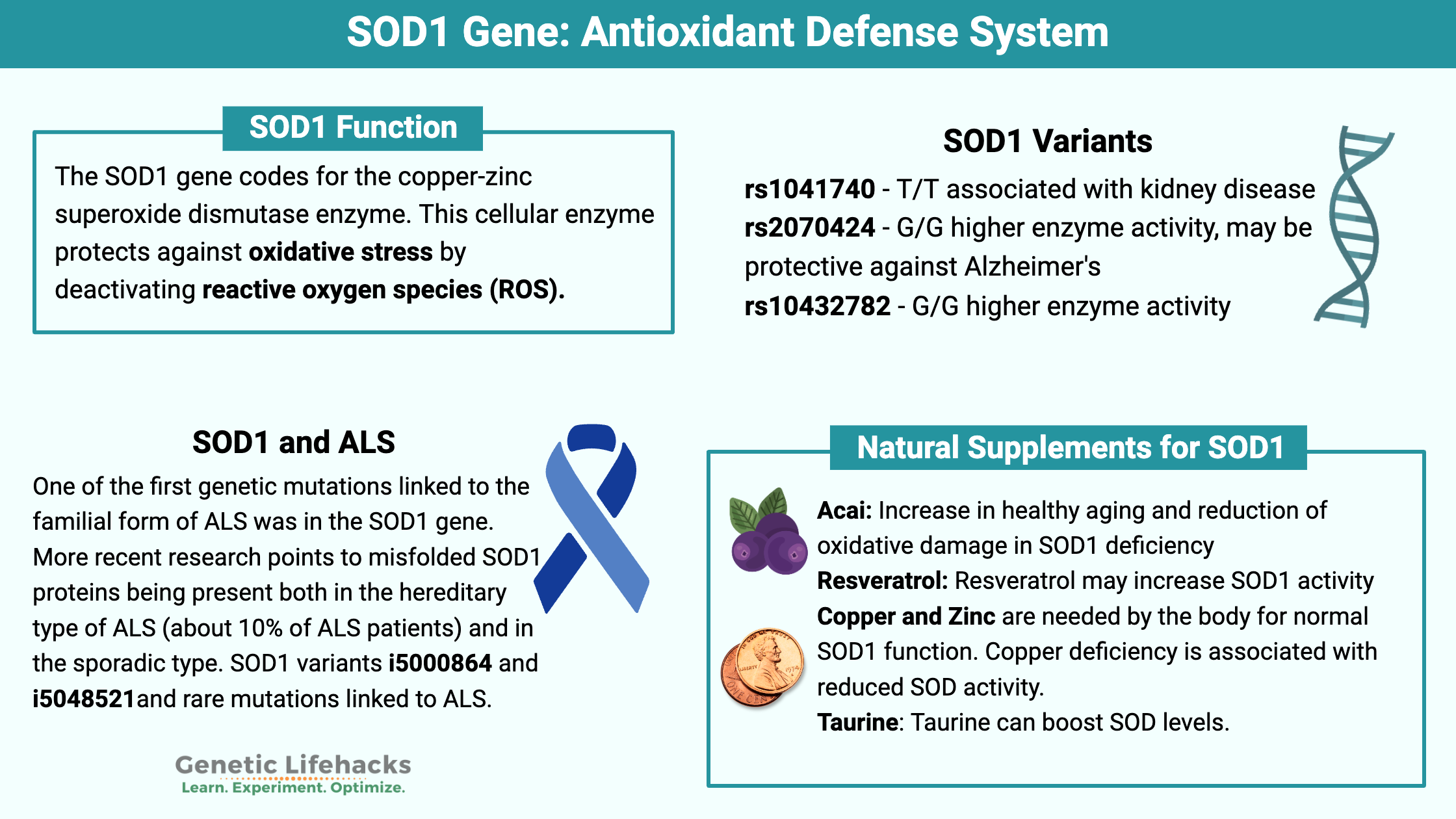Key takeaways:
~ SOD1 encodes an enzyme important in reducing oxidative stress.
~ SOD1 utilizes copper and zinc in neutralizing free radicals, such as superoxide radicals, to prevent damage to DNA and proteins in cells.
~ Genetic variants in SOD1 can affect your body’s ability to cope with cellular stressors.
SOD1: Superoxide Dismutase 1
Our body has built-in antioxidants that fight against cellular stress. The superoxide dismutase (SOD1) enzyme fights against oxidative stress in your cells, constantly battling to balance out oxidants with antioxidants.
The SOD1 gene codes for the copper-zinc superoxide dismutase enzyme. This cellular enzyme protects against oxidative stress by deactivating reactive oxygen species (ROS).
Three types of superoxide dismutases are part of our built-in antioxidant system:[ref]
- SOD1, found in the cytosol or fluid of cells
- SOD2, a mitochondrial antioxidant
- SOD3, which is extracellular or outside of the cells
SOD1 binds copper and zinc ions together and destroys free radicals. It is an antioxidant that our body produces, which converts superoxide radicals into oxygen and hydrogen peroxide. Other enzymes then break down the hydrogen peroxide.
Balancing out oxidation reactions:
This is all about electrons.. Superoxide is two oxygen molecules bonded together but with one electron missing (O2−). Normal oxygen that we breathe in the air is a stable combo of two oxygen molecules.
The superoxide compound, which lacks an electron, is highly reactive, wanting to bind with another molecule to balance out its charge.
SOD1 – superoxide dismutase 1 – can counteract the superoxide produced in cellular reactions. SOD1’s primary function is to convert superoxide radicals (O2−) into hydrogen peroxide (H2O2) and oxygen (O2). The hydrogen peroxide produced is further converted into water by other enzymes, such as glutathione peroxidase.
While we often think of antioxidants as being good and reactive oxygen species (ROS), such as superoxide, as being ‘bad’, ROS does play a vital role in cell signaling. Our cells need to be in balance with antioxidants and pro-oxidants.[ref]
Additionally, our immune system produces pro-oxidants such as superoxide to kill invading pathogens.
Balance is key, and SOD1 provides that balance.
Research on SOD1:
Research on the different genetic variants shows that SOD1 impacts heart disease risk, kidney disease, hearing loss, and diabetes. Oxidative stress plays a role in all of these chronic conditions, and decreased SOD1 (or too much ROS) can contribute to the development of these diseases.[ref][ref]
Oxidative stress seems to play a role in Alzheimer’s disease as well, and SOD1 variants have been studied to see if they affect the risk of Alzheimer’s. For rs2070424, the G allele offers protection against Alzheimer’s disease regardless of APOE gene status.[ref][ref]
Related article: Check your APOE genes (only if you want to know more about your Alzheimer’s risk)
Overall, higher SOD activity has links to decreased mortality in women. Oddly, this statistic didn’t hold true for men.[ref]
SOD1 in ALS:
One of the first genetic mutations linked to the familial form of ALS was in the SOD1 gene. More recent research points to misfolded SOD1 proteins being present both in the hereditary type of ALS (about 10% of ALS patients) and in the sporadic type. While there is still a lot that researchers don’t know here, it looks like the SOD1 mutations cause a gain-of-function and altered folding in a way that causes a loss of motor neuron function.[ref]
SOD1 Genotype Report:
SOD1 genetic variants can cause either an increase or a decrease in enzyme activity. Rare mutations in SOD1 have links to several diseases, including an inherited form of ALS (Lou Gehrig’s disease).[ref] More common variants are linked with conditions such as diabetes, cardiovascular disease, kidney disease, and hearing damage.
Lifehacks for increasing SOD1:
4 Natural Supplements to increase SOD1:
Acai:
Freeze-dried acai powder, in an animal model of SOD1 deficiency, shows an increase in healthy aging and reduction of oxidative damage.[ref] Freeze-dried Acai powder can be found online, and acai juice can be found in most grocery stores.
Related Articles and Topics:
Supplements to boost BDNF:
BDNF is a neurotrophin, which means that it is a signaling protein that promotes neuronal growth, neurotransmitter release, and synaptic function.
Blood glucose levels: how your genes impact blood sugar regulation
Genetics plays a big role in your blood glucose regulation. Some people may be able to get by eating some junk food and not exercising as much, but for others, our genetic susceptibility combines with poor choices to cause elevated blood glucose levels.
Nrf2 Pathway: Increasing the body’s ability to get rid of toxins
The Nrf2 (Nuclear factor erythroid 2–related factor) signaling pathway regulates the expression of antioxidants and phase II detoxification enzymes. This is a fundamental pathway that is important in how well your body functions. Your genetic variants impact how well this pathway functions.
Originally published 10/2015, updated 9/2020

